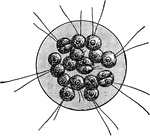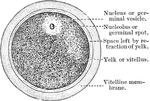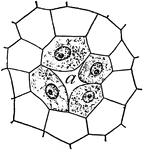
Resin gland of a fir
"Young resin gland of fir: a, duct, an intercellular space formed by the separation of the…
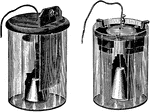
Fuller Cell
"The telephone standard and compound forms of Fuller cell... The Fuller cell is of the double fluid…

Sweat gland
"The convoluted gland is seen surrounded by fat cells and may be traced through the true skin to its…
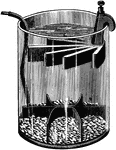
Gravity Cell
"The electric resistance of the porous cup employed in the Daniel cell, and the local action produced…

Grenet Cell
"The elements are zinc and carbon. In the Greet cell, a zinc plate is suspended b a rod between two…

Grenet Cell
"...and is constructed with a zinc plate suspended between two carbon plates, so as to have two carbon…

Grenet Cell
"...and is constructed with a zinc plate suspended between two carbon plates, so as to have two carbon…

Cross-section of a human hair
"Cross-section of One Half of a Human Hair. A hair is made up of horny cells of the outer layer of the…

Hydra
"Nettling cells of Hydra. A, unexploded; B, exploded; b, barbs; c, the nettling cell in which the nettling…
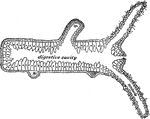
Section of a hydra
"Longitudinal section of a Hydra; b, bud which will form a young one; ba, base by…

Pondweed Leaf
"Vertical section of the leaf of Potamogeton or Pondweed, showing air cavities or lecunae l, and parenehymatous…
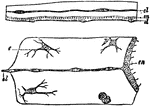
Medusae
"Portions of sections through the disc of medusae. The upper one of Lizzia, the lower of Aurelia. el,…

Muscular Cells
"Muscular cells of medusae (Lizzia). The uppermost is a purely muscular cell from the sub-umbrella;…

The Development of Muscular Fibers from Cells
The development of muscular fibers from cells. Labels: a, simple cell. b, a pair of cells fused together.…

Nematocyst
"Nematocyst of Hydra, showing cell-substance and nucleus, cyat, trigger hair, and everted thread." —…
Nerve Cells
"Nerve tissue is really made up of a great number of distinctive units called nerve cells.…
Neuron
"Showing a motor cell with its long, unbranched process (with two little lateral offshoots), with motor…

Non-Striated Muscle
"Non-striped spindle-shaped cells which branch and join with one another." — Richardson, 1906

Ocellus
"Ocellus of a medusa (Lizzia Koellikeri). oc, pigmented ectodermal cells; l, lens." — Encyclopedia…
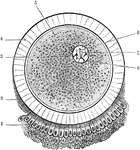
Ovum
The ovum and its coverings. The corona radiata, which completely surrounds the ovum, is only represented…
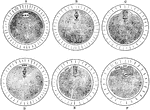
Maturation of the Ovum
The maturation of the ovum. A, An ovum at the commencement process. B, After the formation of the spindle.…

Parallel Connection
Figure showing battery cells connected in parallel, with all of the positive ends wired together, and…
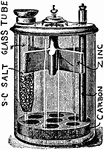
Partz Cell
"Partz acid gravity cell. In this form of cell, the electrolyte which surrounds the zinc is either magnesium…
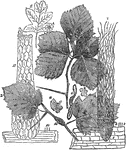
Cellular structure of peridia
"Under the power of about 90 diameters the general character of the peridia is seen. They are densely…
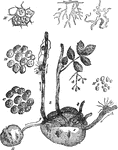
Potato Diseases at a Microscopic Level
"It is not unusual to fine a decayed spot in the center of potatoes otherwise apparently in good condition.…

Protococcus
A genus of single-celled algae often forming a yellowish-green stratum on trees' damp walls, and in…

Sachs
"Splitting of partition wall between guard-cells to form the stoma (Sachs.)" — Encyclopedia Britanica,…

Saxifraga Sarmentosa
"Epidermis of leaf of Saxifraga Sarmentosa, showing clusters of stomata s, surrounded by large epidermal…

Scorpion Eyes
"Development of the lateral eyes of a scorpion. h, Epidermic cell-layer; mes, mesoblastic connective…
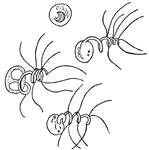
Spermatozooid of the Southern Maidenhair Fern and Venus Hair Fern
Spermatozooid, mature male germ cells, of Adiantum capillus-veneris. Also called spermatozoid.
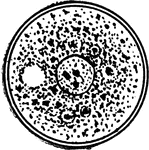
Spherical Cell
"Spherical cell (resting stage of Amoeba) illustrating general or universal symmetry. Any plane passing…

Spirillum
"Spirillum containing many spores (a), which are liberated at b by the breaking up of the parent cells."…
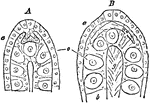
Sporosac
"Two female sporosacs (degenerate medusae) of Hydraetinia echinata. a, ectoderm; b, endoderm; o, eggcella;…
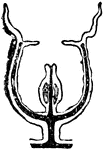
Sporosae
"Gradual degeneration of the medusa bud into the form of a sporosae. The black represents the enteric…

Sporosae
"Gradual degeneration of the medusa bud into the form of a sporosae. The black represents the enteric…
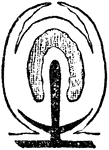
Sporosae
"Gradual degeneration of the medusa bud into the form of a sporosae. The black represents the enteric…
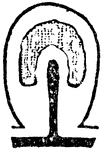
Sporosae
"Gradual degeneration of the medusa bud into the form of a sporosae. The black represents the enteric…
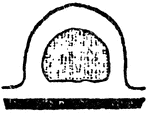
Sporosae
"Gradual degeneration of the medusa bud into the form of a sporosae. The black represents the enteric…

Trachomedusae
"Simple tentaculocyst of one of the Trachomedusae (Rhopalonema velatum). The process carrying the otolith…
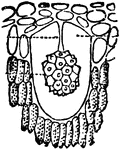
Urostigma Elasticum
"Cellular tissue from leaf of Urostigma elasticum. c, a large cell; r, cystolith, an agglomeration of…
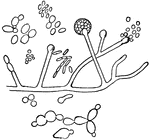
Fermentation of wine
"Organisms found upon the Skin o a Grape and concerned in the Fermentation of Wine." — Blaisedell,…
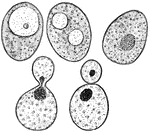
Yeast cake
"Showing a Bit of Common Yeast Cake when mixed with Water and examined under the Microscope. There are…
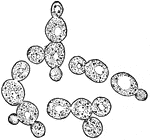
Yeast cells
"Yeast Cells, found in the Juice of Apples, which cause the fermentation of Cider." — Blaisedell,…

Growing yeast cells
Growing Yeast Cells, showing Method of budding and forming Groups of Cells. Each bud appears as a little…
